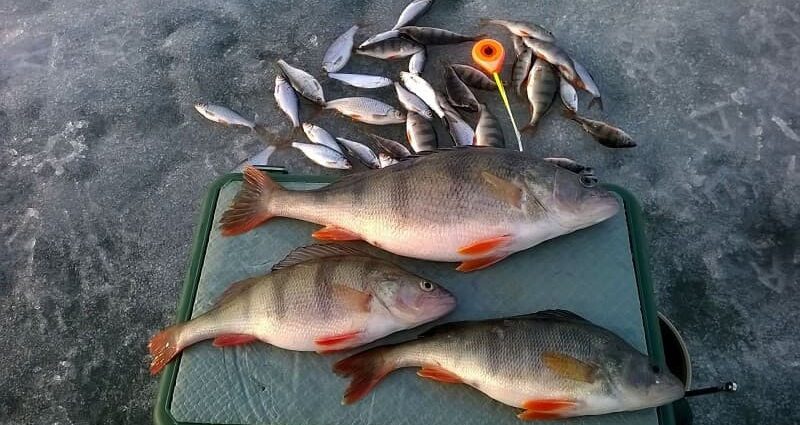Contents
Winter is a great time! Fresh frosty air, silence, New Year’s mood – what else is needed for happiness? Perch fishing in winter allows the angler to relax, have fun and bring home a heavy box of striped trophies.
Ways to catch perch and fish behavior
Ice fishing for this fish is possible in all known ways. You can catch it on a bait, bait, float rod, mormyshka, with or without a bloodworm, all kinds of alternative baubles – bastard, fantomas, bottom. You can perfectly fish on a balancer and even on a summer twister. Of course, some gear will have to be modified for this fish.
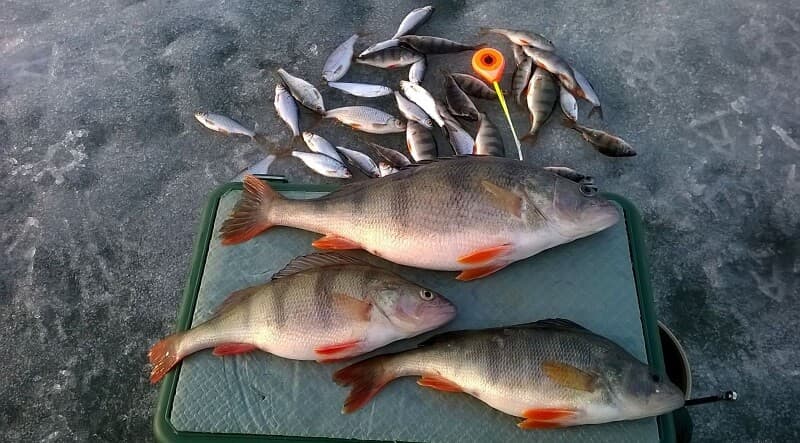
The main tackles that are commonly used are baubles, balancers and mormyshkas. To catch them, it is necessary to maintain certain fluctuations of the nozzle under water – to play. Playing with a nozzle is the main component of success. It allows not only to attract fish, but also to provoke a bite. If the game is played correctly, bites will be frequent. If it is wrong, bites will be rare, capricious. And sometimes you can even scare away the fish.
Attracting fish to the game is associated with the behavior of the perch, its natural instincts and the peculiarities of the fish psyche. It is difficult to say what provokes him to bite. Perhaps some kind of protective reflexes designed to defend the territory. Partly – the stomach, which requires food. Maybe he just wants to play with the bait like a cat with a mouse. Absolutely, the food instinct is not decisive, since it usually feeds very little under the ice, especially in the dead of winter. And only at the beginning of spring, before spawning, it begins to eat food.
On large deep lakes, he tries to follow schools of fry and white fish. Even if it is too large to serve as food for him. There both these flocks and the flocks of the perch itself can reach the largest sizes.
Fishing there very much depends on whether you hit a flock or not, on the number of holes drilled. In shallow water, where there is a lot of undead vegetation, the situation is somewhat different. The perch prefers to stay in it, making small transitions over short distances and rarely gathering in flocks of more than 50-100 individuals. Usually fishing here is more stable, you can even try to wait for a bite by sitting in one place for a long time, rather than running around the ice with an echo sounder, storming a lot of holes.
Behavior under ice
An echo sounder is very important when fishing. It helps to track down the accumulation of fish. In practice, he shows white fish, which are the majority in our reservoirs – this is roach, silver bream, small bream. Surely perch can be found next to it. This will save time on catching holes and vice versa, drilling a promising area more densely.
Perch is a schooling fish. Hungry individuals usually gather in flocks, their size can reach several tens of thousands. But more often there are flocks of 30-50 pieces. Usually they hunt in a driven way: they catch up with a flock of fry, try to surround them and begin to eat one by one. After the hunt, the pack usually retreats to a quiet place. Since almost all the perches caught by the author had an empty stomach in winter, it can be assumed that after a hearty “lunch” the perch becomes extremely passive and does not bite at anything at all.
This also explains the frequency of biting perch. Digestion processes, like any predator, last a long time, up to two days. After hunting, a flock of perch lies on the bottom and does not show any activity. But not always the food instinct drives him when reacting to the bait. For an inexplicable reason, perches become victims of herd suicide. If, in the visibility of a flock, one predator was hooked and pulled up, the probability of the next bite increases dramatically. He is not at all embarrassed by the fate of his comrade, on the contrary, this will only provoke the pack. This is confirmed by numerous underwater shootings, the motto of this fish is: one for all and all for one!
Perch on winter lure and balancer
The traditional type of perch fishing is winter lure. Such fishing has historically been found among all northern peoples, even in the Novgorod Museum of Local Lore one can see winter baubles, forged or cast with a single hook, dating back to the early periods of history. The spinner creates specific vibrations during the game, to which the fish approaches from afar. It can attract fish as an object of food, cause simple curiosity or irritation with its presence.
Blyosny
Of great importance is the selection of spinners. It should not be too large so that the perch can capture it in its mouth, even a small one. The main thing is to find the fish and catch the first one, most likely, it is worth sitting on such a hole and playing for another five minutes. The most difficult thing when flashing is to pick up a game. For each spinner, it should be its own.
By type they are distinguished into carnations and gliders. When thrown, the carnations fall sharply down and to the side, and then return to their original position. The line is almost always taut. The gliders are slowly lowered when played, leaving the line in a loose position. As a rule, fishing takes place from the bottom, and the descending glider is visible from afar. The carnation, on the other hand, allows you to detect the thinnest touch of the bait and provoke the most passive fish with the game. When fishing for perch, carnations are usually used more often, since it is easier to search for fish using balancers.
Balancers
The perch pecks at the balancer. The latter is not so demanding on the game, there is no need to pick it up and it is easiest for a beginner to deal with it. In addition, it gives out wide, sweeping vibrations that are far caught by perch and are able to attract a flock from afar. The value usually has the size of the balancer and its height above the bottom – sometimes the fish pecks under the very ice. Playing with a balancer consists in a moderately sharp toss of 30-40 cm and subsequent release.
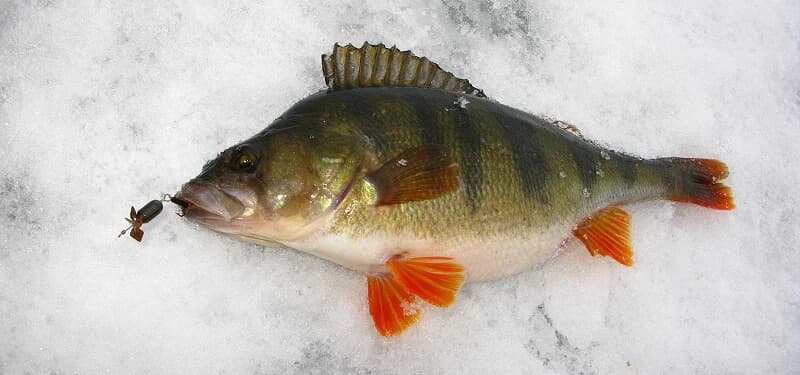
The return to the lower position and the bite are felt by hand, after which they pause. In the game, it is not the toss that is important here, but maintaining the necessary pause with a return to one point. Under the perch, they put a bait no more than 5-6 cm long, both a lure and a balancer, while one cannot judge the catchability by the type and price of the bait. It happens that the spinner looks rough, crooked, but it catches divinely. Everything must be tried.
Tackle for spinners and balancers
A fishing rod for a lure and a balancer should be used quite rigid, from 40 to 70 cm long in the working part. For balancers – a little less rigid and longer. Rigidity is needed for the correct game, you won’t catch anything on a short snotty mormuscular whip on a lure. The jerk of the spinner should not be extinguished by the fishing rod, but transferred to the spinner, it is already lubricated with an elastic fishing line. As a rule, it is equipped with a small reel and fishing line 0.1-0.15 mm. Thicker perch should not be used. You can put a special winter cord, while the rod is used softer and you need to adjust the game of the bait. It is not necessary to use a nod, the bite is well heard by hand.
The angler usually has a separate rod for different types of spinners, for balancers, because he knows in advance how they need to play with a particular bait. After all, it’s not that expensive and can be made on your own. Often a simple change of a homemade rod from the top end of a float rod to a rod from a feeder whip can bring fishing success. It must be remembered that not only the bait affects bites, but also the game, some elusive little thing in the game just changed – and now the bites began, or vice versa, they stopped.
Fishing tactics
This is the whole point of fishing with spinners and balancers – to choose a combination that the fish will like today. But this is important in small water bodies, where perch can be found everywhere in approximately equal density. On large lakes, deep reservoirs, the situation is different. He gathers in very large flocks. This is where finding the fish is crucial. It’s easier to do it in a team. Fishermen walk in a line 50 meters apart, drill holes at the same distance. It makes no sense to go closer in a large area.
As soon as the echo sounder showed the fish or there was a bite, they begin to catch on the hole, if there is no result, they drill this place to the sides with a cross, 3-5 meters each, then move further away until they find the fish. Of great importance is the search for a perch by the whole gang, when he finds one – everyone converges on him, despite, perhaps, discontent. True, it is advisable not to drill anyone under the ass, because you can get a cap with a hot and ice drill.
For such fishing, a snowmobile and binoculars will be a good help. The fisherman looks out for who has bites through binoculars, then gets on a snowmobile and rushes to him. The flock leaves, the search continues. Practice says that the perch hole works no more than ten minutes, during which time you can take out up to thirty beauties – it depends on the experience and speed of the angler’s hands. At the same time, you need to be able to get them out so that no one sees. This is a very exciting fishing, fun, usually there are always a lot of people, there is a spirit of competition and a lot of activity – you have to drill hundreds of holes a day. It is desirable for a fisherman to have not only an echo sounder, but also a flasher.
In shallow water the situation is different. Here they usually drill holes every five meters and follow them. Usually one hole works no more than three to five minutes, it is possible to extract no more than a dozen fish. But you don’t have to go far, a snowmobile is also optional. Having caught the holes, they go back to the first ones, especially where there were bites before. Most likely, the fish will return there in half an hour or an hour. Here it is more important to fish unnoticed by both fish and other fishermen. It is important not to create a lot of noise, at shallow depths – to shade the holes with snow. The number of holes per day is the same, about a hundred, so the load and benefits of fishing are no less.
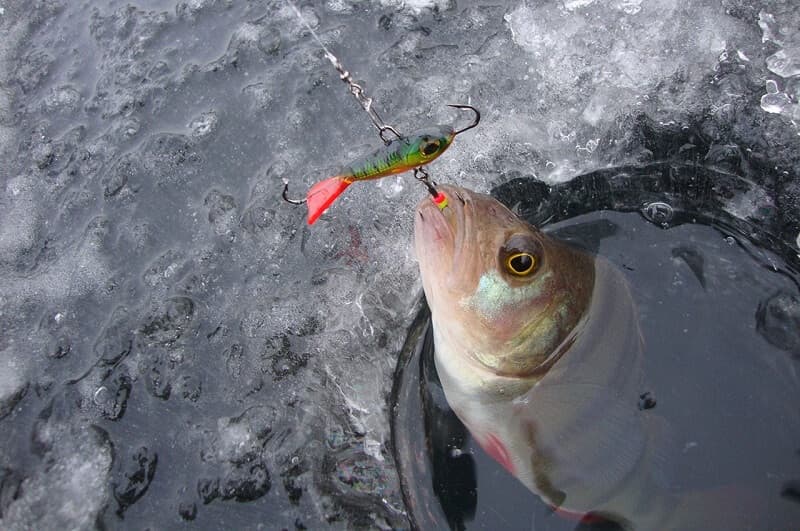
Perch on mormyshka
The most accessible way is fishing for mormyshka. This is how they catch both perch and non-predatory fish. Mormyshki imitate the behavior of not another fish, but some kind of aquatic insect or bug. The nozzle is used, usually a bloodworm serves it, sometimes a worm, maggot and even dough are used. Recently, non-reel mormyshkas have become popular. The game is very important here, as when working with a spinner. After all, it is possible to attract fish by playing from afar, but making it take a revolver in its mouth is already more difficult. The arsenal of tricks for playing with a revolver is also higher here than when playing with a lure.
The main disadvantage of the mormyshka is that it is not so effective at great depths. The fact is that the game is usually hidden by the fishing line and its resistance to immersion. It is most effective to catch mormyshka up to two meters. There you can use the game with a nod, trembling, small jerks, in a word, completely imitate the movements of an insect. Deeper you will have to increase the weight of the mormyshka and use the thinnest possible line, which is not always good – it will be more difficult to release when hooked. You can fish a little deeper with tungsten mormyshkas – up to 3-4 meters. With the same size, they have a greater density, go to the bottom faster and can be played at the same pace.
Mormyshka work
Usually the perch pecks at the mormyshka correctly. For him, they put both nodding and nodding fishing rods. The latter have less mass, allow you to play the game literally with your fingers. In nodding anglers, the nod takes a large part in the game, signals a bite. It is expressed in the failure of the game of the nod or raising it, at this moment they hook. A very good bite signaling device – when the fish takes the mormyshka into its mouth, the load on the nod disappears, and it straightens up. When fishing for roach, the moment of hooking is crucial, when fishing for perch it is less. When fishing with a revolver, the bite is felt by hand, like a lure. There is no need to be afraid that the rod should be as light as possible or something else that you will not feel. A good perch takes so that the bait can be pulled out of his hands. But still, fishing with a light rod is more pleasant than with a heavy one.
The main feature when fishing with a mormyshka is to always keep the tip of the fishing rod low over the hole so that the lines freeze as little as possible. Fishermen go to different tricks. They use a low bent landing, use other methods of catching instead of a box. Traditionally, northern peoples fished from under the ice, sitting on their knees or lying on it, using a thick bedding of straw or skins. Yes, and in the old days we used to bag bream lying on a sled. This has many advantages – the angler is not so blown by a strong wind, which, sitting on the ice itself, cools much less than sitting on a box.
Fishing sport
All this has led to the fact that professional jig fishers like to catch from their knees. For this, very thick knee pads are used, which allow you to stand up even on wet ice, or linings of the same thickness. Holes are usually drilled not so much, but they often move between them, as the fish can come back and peck again. In Russia, Ukraine, Kazakhstan and Belarus, competitions are held in fishing for mormyshka, the perch is usually a trophy. According to the athletes, fishing requires great endurance, you have to literally run between the holes to win the victory. Fishing for perch with a mormyshka can be both an exciting sport and a leisurely weekend getaway. However, you still have to look for perch, drill at least twenty holes a day, because it won’t work much to attract it either with bait or smell – only with a game.
Form ant
According to the type of mormyshka, they are divided into mormyshka and mormyshka. For moth mormyshki, the shape does not really matter. The game usually looks like a rhythmic up and down movement, the nozzle strongly dampens all kinds of jig vibrations. The perch approaches the game, and takes it to the bait. Although, of course, some argue that the shape of the mormyshka matters, however, in practice, size and weight are more important – a pellet, oatmeal, bug and lentil of the same size and density will work about equally effectively with the same nozzle.
Mothless mormyshki
The reelless mormyshkas, on the contrary, have a spectacular game. Most often, a replant is used, which is cut with scissors from edible summer rubber, sponge pads impregnated with flavoring and other materials. The bait allows the fish to get a taste and increases the time the angler can set. Various beads are also used, which are put on a hook. They ring underwater to attract fish. According to non-winders, the bead affects the biting of the perch even more than replanting and mormyshka.
The most ancient and popular type of revolver is the devil. Mormyshka, which has a soldered tee, allows you to put the bead symmetrically, asymmetrically on one of the horns, to replant also asymmetrically or symmetrically. All this, as well as the shape of the devil himself, make it possible to achieve an effective game. The fisherman, having identified a good devil and the correct game for him, then tries at home in a basin of water to understand how it looks under water and pick up other similar devils, soldering them, putting beads, the same replants, screwing the pile on hooks or flags, etc. d.
Other mormyshkas for reelless fishing are goat, carnation, nail ball, bug, etc. Anglers use them for both perch and other fish, most often they make them themselves. The author is not a great specialist in catching them, but we can say that the most effective reelless was shown when catching silver bream and … ruff. It has always been easier for me to catch perch on a lure and a balancer, as well as on a bloodworm mormyshka. The devil for catching silver bream in winter is just perfect, and even in the dead of winter it was possible to catch this delicious fish.
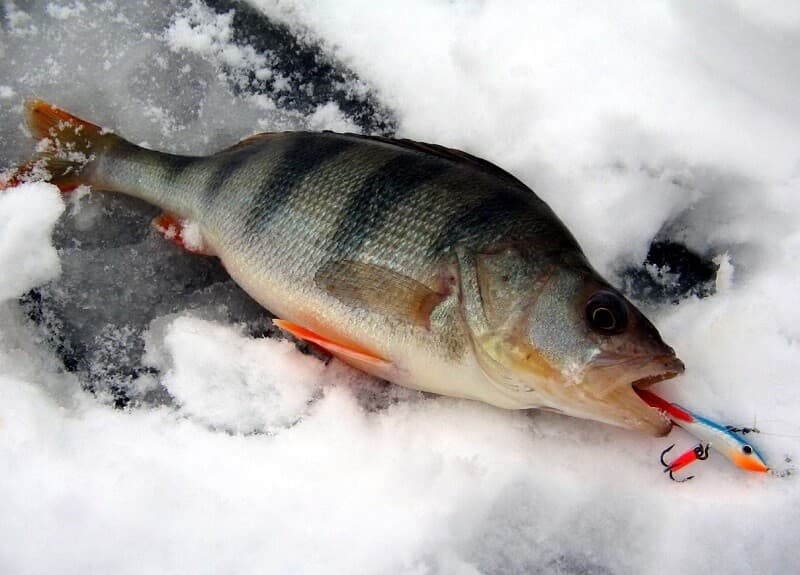
Fancy perch lures
There are a number of lures that have shown their effectiveness when catching perch, but are neither traditional mormyshki, nor spinners, nor balancers. They should be discussed separately.
Bottom spinners
Described by the Shcherbakov brothers in sufficient detail, they are used for fishing at depth. The bottom line is that the spinner during the game does not return to the water column, but falls to the bottom. At the same time, a cloud of turbidity rises, and the perch approaches the knock and this cloud. There are many varieties of them, frogs, Honduras, fantomas, and others. They are made by the fishermen themselves, they also give them names. Their design is uncomplicated, the game too, and they can be recommended to beginner anglers. The main thing is that when manufacturing after soldering, let it rest in soda and sharpen the hooks, otherwise they will rot very quickly in water.
With replanting
Many people put a worm on the spinner, as well as on the balancer on the lower hook. This helps to cause a bite, but greatly disrupts the game of the spinner. There is a spinner and a balancer with a chain and a perch eye. Instead of a hook, a chain is placed on a spinner or balancer, at the bottom of which there is a single hook. An eye is planted on him from a perch caught earlier. The tackle is adjusted so that when moving, the balancer plows the bottom with this eye on the chain, raising the dregs. The chain has very little effect on the game and is more effective than just a worm on a spinner hook. Perch, indeed, more securely holds a bait that tastes of blood, whether it is colorless worm blood or perch blood.
Fishing for bait
The method is more often used when catching pike, but often the perch sits on the live bait. The main problem is to get a live bait of a suitable size, no more than 7-8 cm in length. It is more difficult to catch fry in winter than in summer. You have to use homemade muzzles from a plastic bottle where they put bait, but it is also important to know where it stands in the winter. In addition, he lives on the hook less than a full-fledged live bait, and you need to run to replace it more often. Therefore, anglers often put on the hook not a live bait fish, but a simple worm. The perch also bites on it, and there is less fuss with it.
Non-standard baits like balancers
Rattlins, cicadas, amphipods are used. They have a more pronounced game than the lead balancer. Rattlin also has a sound due to the presence of balls inside. Summer and winter rattlins differ from each other. Amphipod is a special balancer invented by Ukrainian fishermen. It performs complex three-dimensional oscillations upon return, close to a spiral arc. This allows you to collect perch from a greater distance. Cicadas, or bladebaits, are one of the best baits for spinning in the summer. Perch are crazy about them and take better than turntables, but they are also more volatile. The winter cicada has a sheen and play like a regular balancer, but visible from a distance. You can try to use a summer cicada if there is no special winter cicada.
Floating rod
Especially perch are rarely caught on it. It can be justified in two cases: either it is a very passive perch that takes only a stationary bait, or it is a very tempo fishing, when the fish takes the bait already on the fall, and at this time the angler removes the perch from another rod and casts it. In the first case, the bite of a perch occurs when catching other fish, and in the second, a lure or mormyshka is often used to make the fish come from afar, and then they are caught on a float. Animal bait is often used, delivering a large amount of bloodworm to the bottom, which keeps the fish. They usually fish with two or three rods. At a very great depth and in a strong current, this method is in second place after the spinner, since playing with a jig in such conditions is impossible. When fishing, it is still worth sometimes playing along with the bait, since such a nozzle will more likely fall into the perch’s field of vision.
Lummox
It is a body with hooks on the sides. When fluctuating, the hooks beat against the body of the bulldozer, creating a ringing and attracting a perch. As the shooting of the Shcherbakov brothers showed, already at a shallow depth the bulldozer does not have such a game, and the hooks simply hang along the body without moving during the game. And in general, we must remember that almost any spinner at a depth nails more strongly. However, when fishing in shallow water, the Balda shows good results and does not require special skill when playing it.










